Earlier this week, I wrote a story about EV charging company Orange and how it is taking a different approach to putting chargers everywhere. Instead of a few high-speed chargers, it makes it easy for multifamily dwellings (think apartment buildings) to put charger sockets everywhere there might be EVs, taking care of billing and such to turn electric sockets into a revenue stream for building owners while making it easy for EV owners to charge their cars.
It’s a clever model, replicating the benefits of charging at home using simple charger infrastructure. I asked the founders if they might be interested in sharing their pitch deck. To my delight, they said yes!
We’re looking for more unique pitch decks to tear down, so if you want to submit your own, here’s how you can do that.
Slides in this deck
- Cover slide
- Mission slide
- Problem slide
- Macroeconomic market slide (“Why now?”)
- Market size slide
- Solution slide
- Value proposition slide
- Product tech spec slide
- Product slide
- Competitive landscape slide
- Competitive advantage slide
- Business model slide
- Cash flow slide
- Go-to-market slide
- Team slide
- Advisers slide
- “The ask” slide
- Contact slide
- Appendices cover slide
- Appendix I: Product install photos
- Appendix II: 3-year financial projections
- Appendix III: Headcount slide
- Appendix IV: Sources and references
Three things to love
Orange Charging’s pitch deck is one of the best decks I’ve seen in a very long time — it looks good, it tells a coherent story and it touches on all the parts that investors want to see in a deck. It even includes great examples of slides that many startup founders get wrong. In fact, when I first scrolled through the deck, I found myself wondering if I would be using this as a teardown at all — what’s the use in criticizing something that’s almost perfect?
Let’s start by taking a peek at some of the highlights.
Amazing summary slide
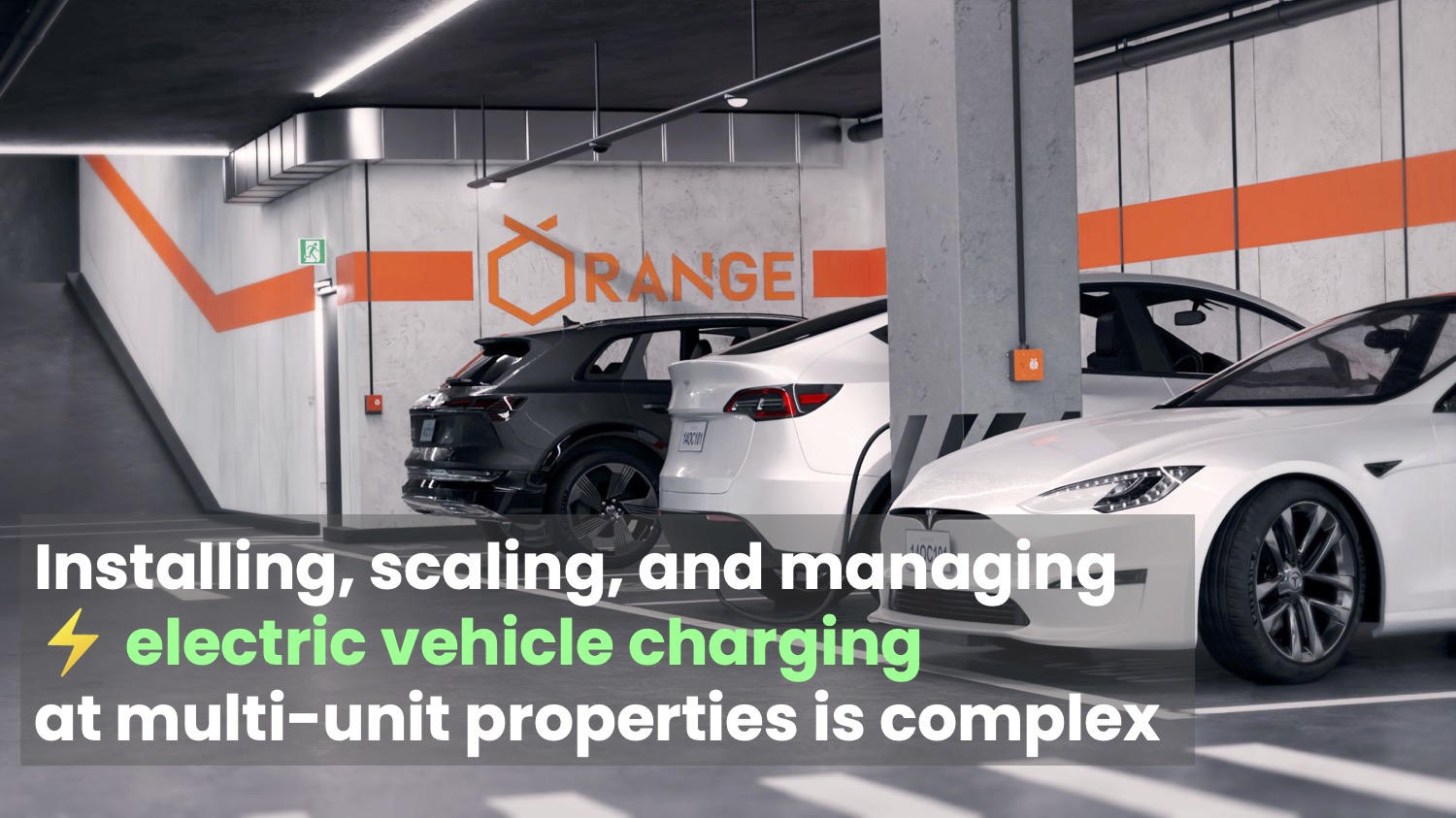
You only get one chance to make a first impression, and Orange’s second slide does a hell of a job of that in several dimensions. Visually, this is a stunning slide; the bright orange stripe that runs along the walls of the garage (it looks like it may be a Photoshop job rather than a paint or vinyl job, but that doesn’t matter for the purpose of a slide deck); the three cars and the bright orange charger boxes are all great visuals.
Then, the text. It encapsulates the problem the company is solving in a really simple and easy-to-understand way.
For a perfect score here, I would have made this slide about the company. Make the text orange and change it to something like “We simplify installing, scaling and managing ⚡️ electric vehicle charging in multiunit properties.” That way, it isn’t about the problem — it’s about the company and the solution. A small box showing the company’s progress and the purpose of this fundraise (“500 chargers installed in 75 locations, raising $2.5 million to 10x our install base”) would be even better.
Great overview of value propositions
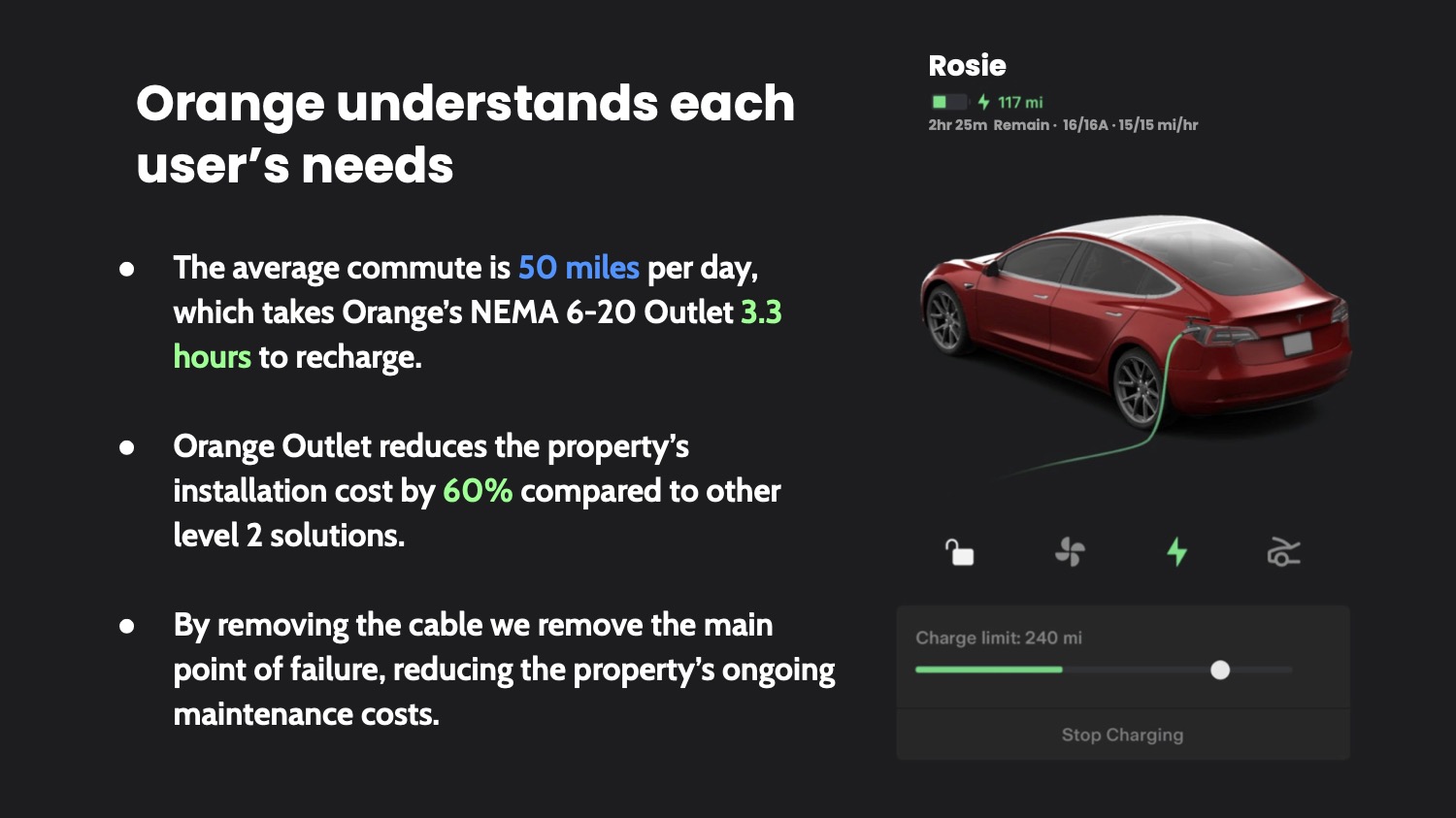
In a world where people are very used to Tesla’s Supercharger network on one hand and the general idea of gas stations (where you fill whenever you get close to empty) on the other, Orange’s take is different from both.
Instead of rapid-charging from time to time or filling up only when you are empty, the company offers a solution that people who charge at home are used to: Whenever you get home, plug your car in, and you’re good to go whenever you get back to your car. Turning this charging paradigm into a company is essentially the core of what Orange is doing.
This slide helps explain why having a 110V or 240V socket installed, charging at 16 amps, is actually plenty for the vast majority of EV drivers. It also argues that lower installation costs (and the absence of a charging cable that can break) and ease of operation make its solution a great alternative to competitors.
Which is a fantastic setup for the two competition slides that follow.
Spectacular market slide
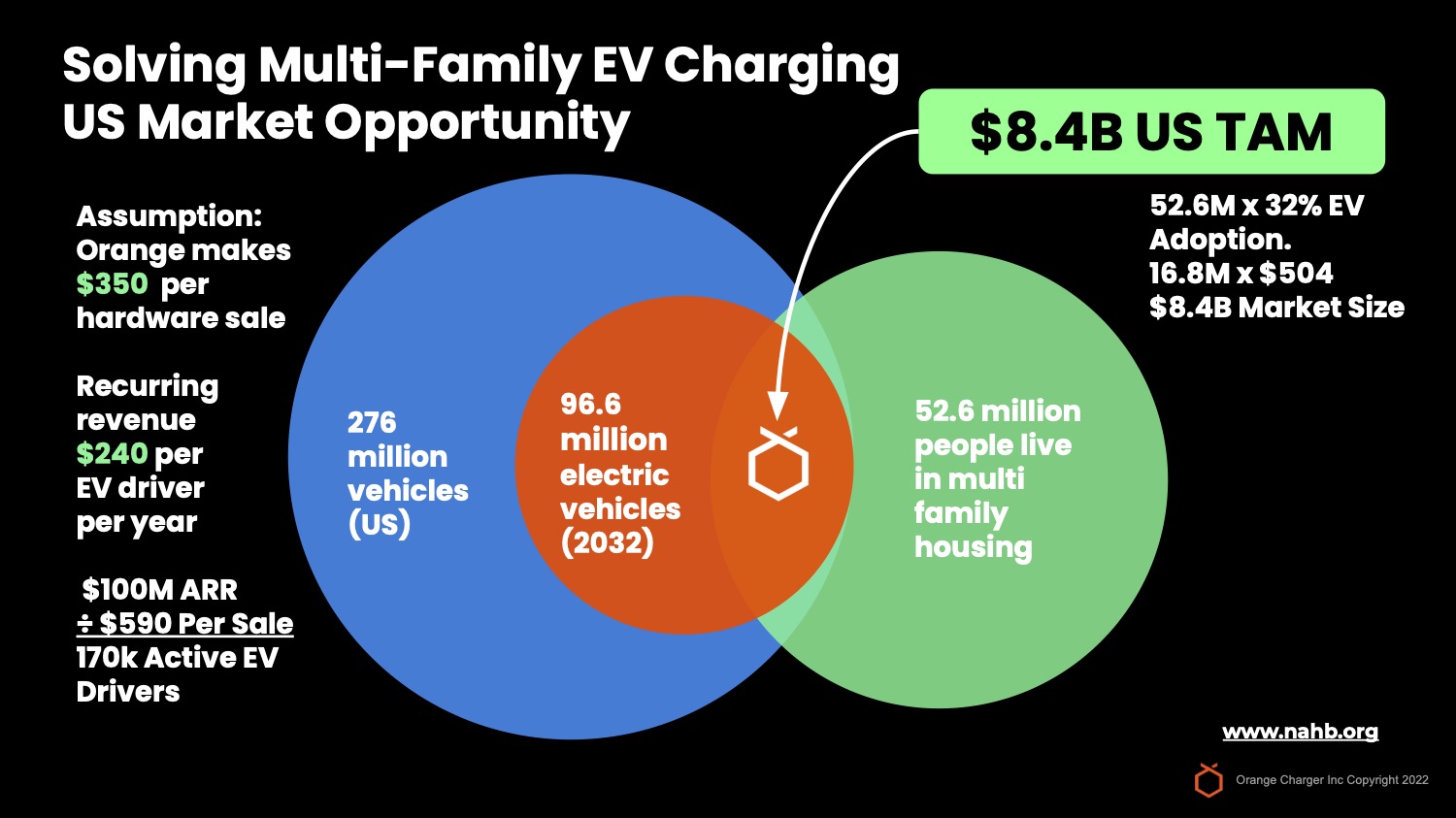
It’s a rare opportunity to be in a world where you are 100% certain that a huge shift in an important market is coming. That is true for electric vehicles and all the infrastructure that comes with them. No investor worth their salt is going to argue with a company that says EV charging is a huge, worth-solving problem. Seeing it presented with this level of clarity on a slide, though, is reassuring and exciting to anyone who’s been keeping an eye on the rapid proliferation of EVs.
On another slide, Orange makes the argument that EVs will cost the same as gasoline-powered cars by 2025 — I’m a little skeptical, but the date is less important than the fact that this is going to happen at some point. Add in government incentives (either punitively in the form of higher gasoline taxes or a more carrot-like approach with new incentives for electric vehicles), and you’ve got a really interesting market indeed.
In the rest of this teardown, we’ll take a look at three things Orange could have improved or done differently, along with its full pitch deck!
Three things that could be improved
The things that could be improved for this deck are a little unusual. Honestly, I don’t really think that the first two examples are things that the company can improve. These things can’t be changed with a tweak of the pitch deck or a slight change in the story; these are fundamental challenges for the company on the whole.
When I’m working with a company on its investor presentation as a consultant, these are things I see as “red flags” — in other words, unless this is resolved, the company is either going to be unable to raise or have a very hard time indeed.
Of course, in this case, the company did successfully raise a $2.5 million round — but unless it is able to address these questions over the next 12 to 18 months, things won’t be pretty when Orange tries to raise growth funding farther down the line.
Is this a race to the bottom?
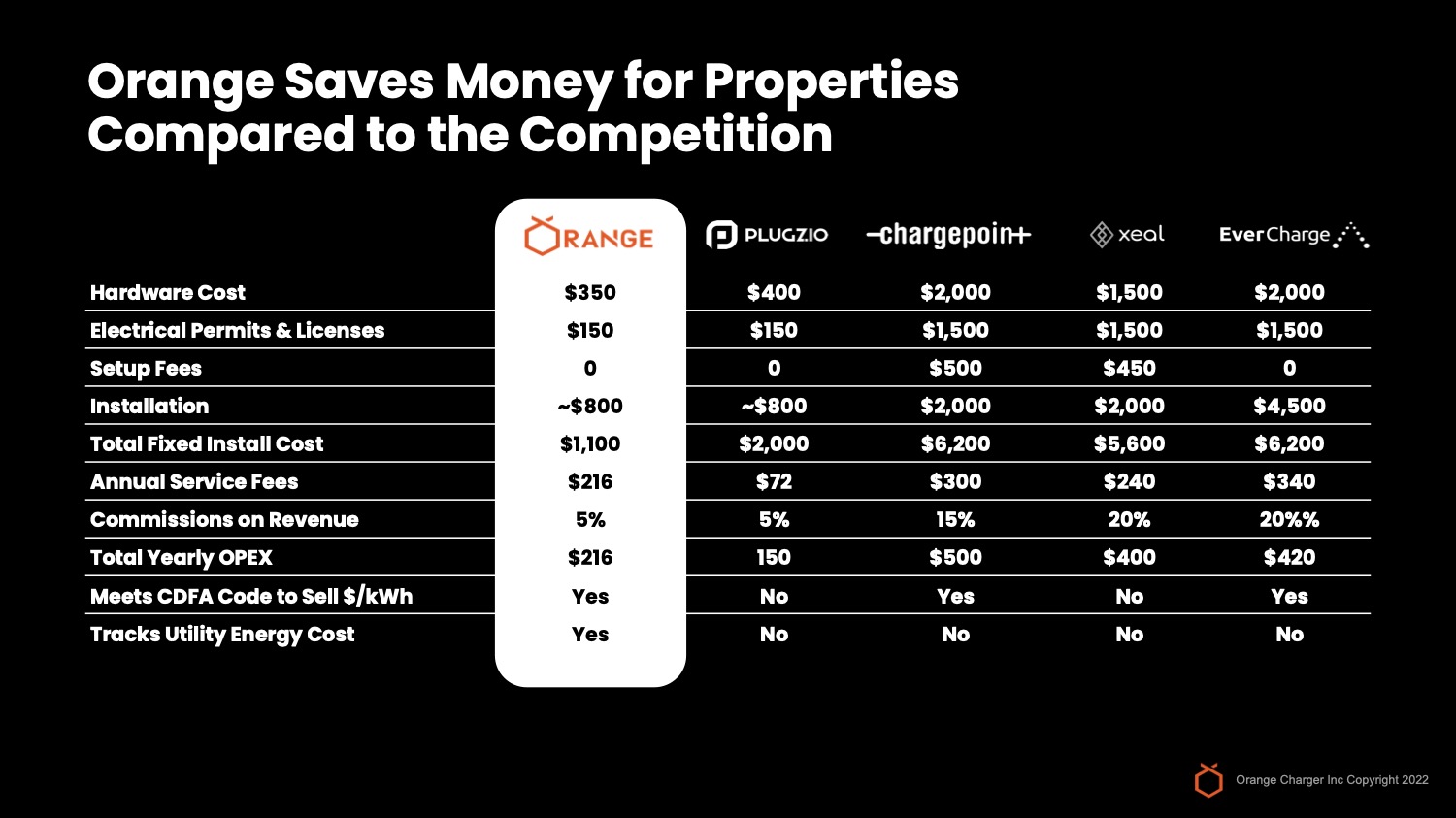
Going from Slide 9 to this slide is a really solid move; it indicates why there’s space for Orange in the marketplace. It shows how the company is placed in the market competitively, and from there, it’s easy to extrapolate how Orange might be a good alternative.
I’m not 100% sure exactly how this comparison table works: The “total fixed install cost,” for example, doesn’t add up with the line items above, so I’m unsure what that refers to. It would also have been helpful to define CDFA, along with what the main difference is between Orange and Plugzio — on paper, at least, they look pretty similar, and if being CDFA code compliant and/or tracking utility costs is important enough, I’d hazard that Plugzio is already on the case of developing or rolling it out.
The main problem with this slide, however, is how the company appears to be positioning itself in a race to the bottom. If the main benefit is price, what stops another company from coming along with a price point that’s a little bit lower and eating into Orange’s business?
What is the competitive moat?
The best startups out there have a “moat,” or a reason why would-be competitors can’t swoop in and take them on. That seems to be absent for Orange — or at least it isn’t made explicit in the pitch deck. As an investor, I’d be worried: What if a better-funded startup comes along with a cheaper price point? Or what if a better-connected startup comes along that has raised money from some of the very large building companies out there?
At first glance, there’s very little that’s defensible about Orange; a good set of engineers can create the app, back end and hardware in not a lot of time. Truly, the “stickiness” of Orange is largely connected to its install base, its brand and its sales processes, but as a young company, none of those things are really there to shout about.
If anything about what Orange is doing is patentable, that might be one way to get a moat. As it stands, it could very well be a fantastically successful company, but it’s going to be a competitive bloodbath if three or four more companies enter the same market doing essentially the same thing, competing for a relatively small number of customers.
Slide consistency
Check out the bottom right corner of each slide as you click through the deck. The copyright notice jumps around from place to place (and some of the copyright notices say 2021 instead of 2022). The same goes for the titles; they aren’t all in the same place on the slide. I know this is the tiniest, most ridiculously nitpicky thing to note, but … attention to detail is important, and there’s not a lot else I can whine about for this slide deck, so please allow me this nitpick!
The full pitch deck
If you want your own pitch deck teardown featured on TC+, here’s more information. Also, check out all our Pitch Deck Teardowns and other pitching advice, all collected in one handy place for you!
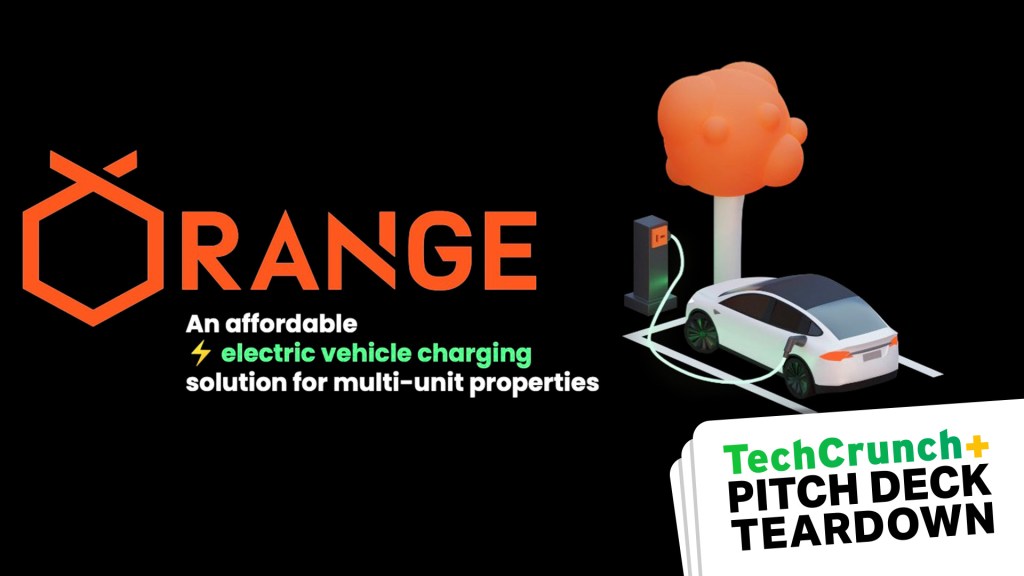






























Comment